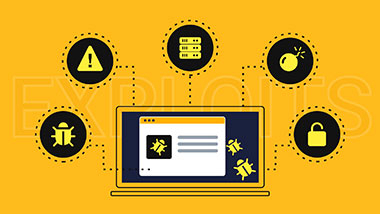
What is an exploit?
Exploit is a program, or a piece of code designed to make use of vulnerabilities. It is never a stand-alone element, but a complementary element of a large-scale cyberattack. While being available for application even in home user systems, they are mostly seen in attacks on companies.
Using exploits, cybercriminals typically escalate privileges or gain access to specific areas of the target environment. This is a stepping stone towards executing the code needed to deploy additional payloads, performing lateral movement and disabling security tools. Since exploits are rather small and often bear on a legit program, security tools do not trigger on such an event.
Why do Exploits Work?
Exploits appear when the developers forget or ignore the testing and checking for possible security breaches. Of course, these breaches are created unintentionally, but most appear because of inattentiveness. Sometimes, exploits appear because the use of low-quality code - a quick and "dirty" solution, leading to numerous bugs and malfunctionings in the future. Exploits are just the consequence of this poorly designed code.
As some software solutions are known for having a whole pack of vulnerabilities, hackers may target them specifically. While the use of Adobe software is rather predictable, detecting other exploitable programs commonly requires reconnaissance. This, eventually, forms the classic stages of a cyberattack.
Read also: CrushFTP's Unauthenticated Access Flaw Discovered
The process of exploiting: how it happens
As we said above, exploits are not stand-alone malware. To succeed with its execution, hackers should, obviously, have initial access to the network. For this, the malware of choice is either a backdoor or a remote-access trojan. It provides facilities for uploading further malware, as well as performing reconnaissance (if it is not done before the attack).
From the recon information, attackers make further decisions not only about the exploitable apps, but also about the entire course of further actions. This step may take several days, or even weeks - depending on the size of the environment. Then, the initial access tool delivers and runs the exploit - which is often coded during the aforementioned several days break.
Besides the software products, exploits may also appear in the databases and websites that use them. They belong to SQL vulnerabilities. Again, the reasons are the same - the poorly-configured or outdated database software. The consequences of such an attack may be less severe, though will most likely inflict unrecoverable data loss.
In case of poorly-designed database requests filtering, hackers may send the database a request to send him whatever. For example, they can ask to show all data about the salaries in your company throughout the year or the total amount of insurance paid by the employees. Such information may have a significant impact on the company’s image. And imagine that such a poor request design is used in the database, which backs the social network or dating app. Leakages of the users’ private info or other data, which must be kept private, equal ill fame to the end of the network’s life.
Read also: CISA Adds 5 Exploited Vulnerabilities, Patch ASAP
Which viruses are injected through the exploits?
Using the exploits allows cybercriminals to inject any virus - depending on their wish. However, it is essential to note that they will not inject adware, hijackers, or scareware of some sort - it carries high risk for too low profit. All cyber crimes are uncovered sooner or later, so cybercriminals do not throw around spare change.
Typically, through the exploits in Adobe products, fraudsters inject various spyware, stealers, coin miners, and sometimes - downloaders. These viruses are among the favorite sources of confidential information since they can steal whatever and wherever. Of course, you cannot predict which virus you will get, but when you have some valuable information in your system, it is better to avoid any viruses.
Is it possible to prevent exploit attacks?
As mentioned multiple times, the exploit results from the developer’s mistake. Responsible developers who support their products and hunt for each bug and problem in their program will release the security patches. Lasts exclusively consist of exploit fixes. Installing these updates as soon as they are released to the public will undoubtedly be protected them from being hacked.
The same thing is with the cases when a hacker can send the server a request that will give him some dangerous return. Ask your back-end developers to check precisely each piece of code to prevent its usage by cyber burglars.
The final security layer is an antivirus program. Security tools with proactive protection can prevent the malware from launching if the exploit was successfully used and fraudsters injected a virus into your system. The proactive protection feature operates on the heuristic engine - a unique mechanism that allows the antivirus to scan each running process and open a folder for possible malicious activity. Gridinsoft Anti-Malware can offer you such functionality.
Read also: BeyondTrust Remote Access Vulnerability Exploited, Update Now
